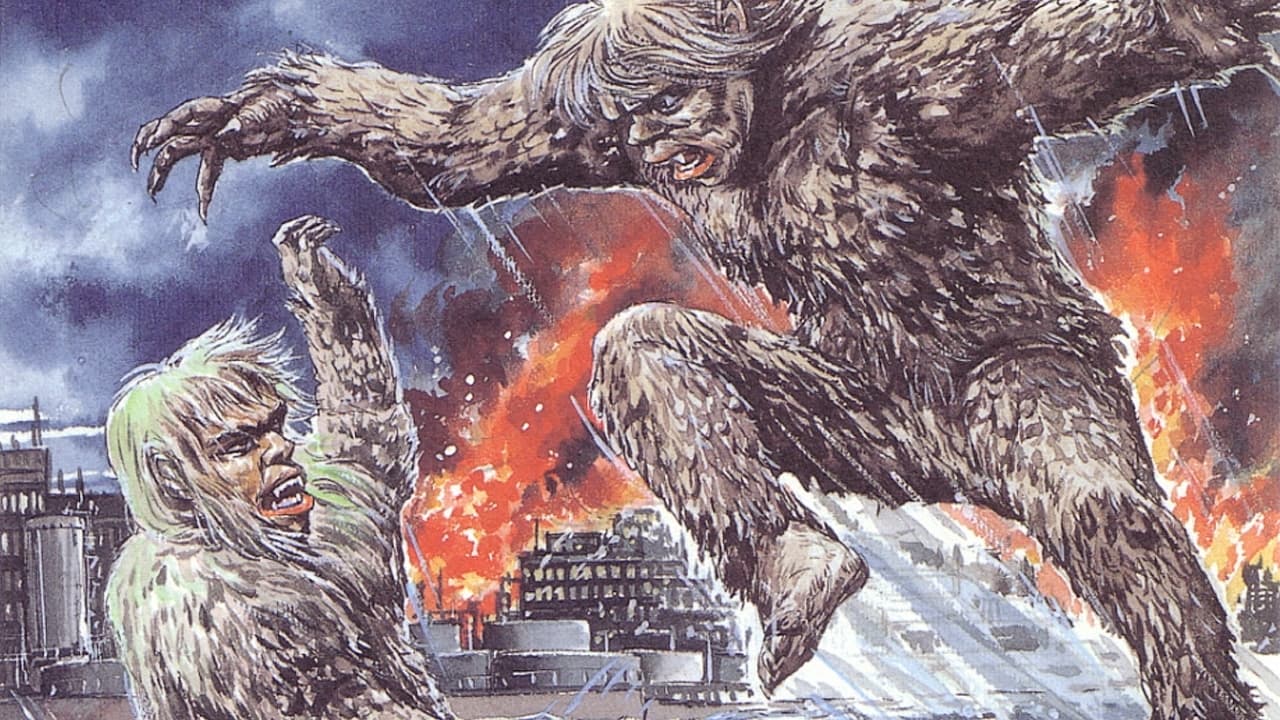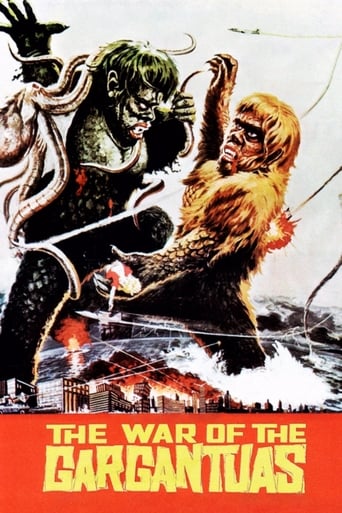

An experimental lab animal called a gargantua escapes from his captors and is suspected to be the creature that is killing people all over the countryside. But when the gargantua from the lab appears at the same time as the evil gargantua, the two begin to battle across Japan.I love seeing Russ Tamblyn in any movie, and here he is so young (and yet somehow a respected doctor... well played). He really made the film for me, and distinguishes it from many other monster movies.I do love the awesome monsters, the effects, the suits. The squid creature in the beginning was excellent and very creepy. The gargantuas are cool... like giant Sasquatches.My only real complaint was the inclusion of the most terrible singer who ever lived. Apparently this was Kipp Hamilton, who had an otherwise lackluster career and died young (age 45). I hate to be rude, but her "talent" is not missed.
... View MoreWar of the Gargantuas is a movie that stems from another dark-themed monster movie, 1965's Frankenstein vs Baragon. Even from the beginning it has a sort of dark theme, with a sinister looking Gaira attacking Oodaku (giant octopus). As Gaira thoughtlessly devours people, you're tempted to cringe. But the hero gargantua, Sanda, brings another piece into the story. It becomes a battle of brothers, one dark and evil while the other is for all intents and purposes good and pure.This isn't your average monster movie, but in a lot of ways that's a good thing. This is one of those dark, near-horror style films that Toho produced in the 50s and 60s, such as 1954's Godzilla or 1958's H-Man. The more human like nature of the gargantuas draws the viewer in and draws out more emotions.It's worth mentioning that although the film is a direct sequel to Frankenstein vs Baragon, almost all of the relationship between the two films is edited out of the American version, leaving a lone comment on the main protagonist discussing a 'hand' he's been studying. That would be Frankenstein's hand. Another thing mostly edited out of the American version is the more romantic relationship between the doctor and his assistant. You get that kind of vibe even in the edited region one release of the movie nonetheless.If a lot of the campy 1960s or 1970s Godzilla films don't do it for you and you want something darker, more serious, near-horror, War of the Gargantuas is for you. It's a fantastic film with the only real weak point being lack of character development. You don't really care even when they're in danger, but otherwise there are few faults. I wouldn't even mind if Toho decides against ever creating a remake of the film, because its quality even roughly a half-century later is superb, and they probably wouldn't capture the spirit of the original, much like other classics such as King Kong (1933) or Godzilla (1954).Looking outside of this specific film, I'm actually glad they elected not to place the gargantuas in a Godzilla movie (Toho originally had written up some loose plans to make a "Godzilla vs Gargantua(s)" for a 1978 theatrical release). In the 60s and especially by the 70s, Godzilla had become campy and "fun". While there's nothing wrong with that in itself, bringing a gargantua would weaken their story much like the campy Godzilla films greatly weakened Godzilla's (1954) reputation as a dark horror movie. Both monsters have their place, just not together.
... View MoreIn case you've been asleep for a while, this is the sequel to Frankenstein Conquers the World, in which the Frankenstein monster has grown into two giant creatures. You see, it was established in the first film that the monster, if in parts, would continue to regrow itself, and so that's what happened. A part grew into a creature in the ocean, and another as a land creature, one good and one not. The creatures have a fondness for each other, basically being brothers of a sort, but the evil one eventually disappoints the good one, and then hell breaks loose with one of the best giant monster battles ever from Toho, second only to Kong and Godzilla. These monsters are the type that would make any creature fan proud and a vast improvement over the original Toho Frankenstein. They must have been listening to the fans about the first one's appearance because they did it right this time.
... View MoreI ranked this movie so high because it's a must-see for anyone who likes horrible movies. As Japanese monster movies go, this ones a classic. Russ Tamblyn, five years after his bold and exuberant role as "Riff", the leader of the Jets street gang in West Side Story, has been down-graded as an actor by the time he takes the role of the intense doctor in War of the Gargantuas. His total disgust at having to compromise his earlier aspirations of stardom are clearly reflected in his WOTG performance where every one of his lines seem spoken while trying to stifle projectile vomiting. My guess is that the only reason he doesn't break down in tears in front of the cameras while muttering "Why me? Why me?" is because he didn't cash his paycheck from the Toho producers before filming. For this reason alone, WOTG is an example of Mr. Tamblyn's best acting.This is just one aspect of why this movie is a gem. I first saw the film during a late night horror show in the 70's. The Green Gargantua (the bad guy in the movie) was perhaps the ugliest thing I had ever seen and the star of many nightmares for months afterward. He looks like a giant hockey player covered in green carpet and scales and sporting a face that's a cross between an angry Frankenstein and a cosmetic surgery addict (you know the ones I mean). Green Gargantua is unstoppable as he teases the unsuspecting citizens by periodically popping out of the ocean only long enough to run across the tarmac of Tokyo International Airport and munch on the occasional lounge singer before jumping back into the safety of Tokyo Bay. Can you imagine how much of an inconvenience this must have been for the air traffic controllers? I mean, it's hard to plan for that kind of thing.As usual, mankind gets sick of being treated like Crunch'n'Munch and eventually lures G.G. into the countryside where they are hoping to destroy him by performing the gargantuan equivalent of throwing a toaster into a bathtub and carving him up with those handy-dandy masers (those giant flashlights on trailers that shoot lightning). Man, if only the Japanese would have had that technology 20 years earlier. The outcome of WWII would have been mighty different, I tell you. Anyway, G.G. gets torn up and Brown Gargantua (the good guy in the movie)finally shows up to save him. We see Brown Gargantua once earlier in the film as a baby when we discover that Russ Tamblyn's character (along with his assistant, the beautiful Akemi) used to be kind of like his Au Pair when the little bugger was just a Springer Spaniel-sized, milkshake-drinking squirrel monkey. B.G. is much bigger than G.G. (and comparatively more handsome by Gargantua standards) and is able to talk the Japanese army into stopping their assault on G.G. by waving his hand and yelling (B.G. is much more of a diplomat than his green flesh-eating brother).The last act of the movie has B.G. breaking his leg while saving Akemi from a fall, then giving G.G. his walking papers (a tree to the face) after discovering all his new room-mate does is lay around the forest apartment all day eating up everything in the frig (aka, hikers and boaters). G.G. tears back to Tokyo (and I don't mean that slow, cocky saunter we get from other Japanese monsters, but an all-out sprint the likes you have never seen) while a limping B.G. pursues him (I don't know if it's to talk some sense into G.G. -- "Hey, eating people is BAD" -- or what, but it's a needed plot point for a dramatic ending). B.G. catches up to G.G. in Tokyo and they duke it out to a standstill (and you can't tell me B.G. wouldn't have mopped the floor with G.G. if his leg weren't broken). Russ Tamblyn's character and Akemi do their best to keep the armed forces of Tokyo from killing B.G. in the chaos, but are unsuccessful. Obviously, the military has caught wind that Russ Tamblyn is no longer the leader of the Jets street gang and has no authority over them. The two gargantuas continue to fight through the city and into the bay where, low-and-behold, a volcano has just decided to erupt and boil the two monsters as they flail away at each other. The ending shot is of the erupting volcano and the boiling bay accompanied by very sad music. I'm sure the music is designed to keep the audience from following their instinct to say "Yea, the Green Gargantua is getting boiled!", but instead, motivate them to say "Darn, the Brown Gargantua is getting boiled!". My eyes are getting misty just thinking about it.So, there you go. Enjoy it for what it's worth -- a testament to the importance of more enlightened Gargantua conservation laws.
... View More